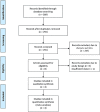Effects of diuretic administration on outcomes of extracorporeal shockwave lithotripsy: A systematic review and meta-analysis
- PMID: 32134993
- PMCID: PMC7058295
- DOI: 10.1371/journal.pone.0230059
Effects of diuretic administration on outcomes of extracorporeal shockwave lithotripsy: A systematic review and meta-analysis
Abstract
The present systematic review and meta-analysis of randomized controlled trials (RCTs) was conducted for investigating the effect of diuretics on the outcomes of shockwave lithotripsy (SWL) for the treatment of urinary stones. We performed searches of PubMed, Web of science, Embase, EBSCO, and Cochrane library databases from inception to November 2019. RCTs were selected for assessing the effects of diuretics on fragmentation and clearance of urinary stones. The search strategy and study selection process were performed in accordance with the PRISMA guidelines. Four RCTs were included in the meta-analysis. Overall, intervention groups experienced significant improvements in fragmentation compared with the control groups (risk ratio [RR] = 1.14, 95% confidence interval [CI] = 1.05-1.03, P = 0.02). However, stone clearance did not significantly differ between the intervention and control groups (RR = 1.23, 95% CI = 0.97-1.56, P = 0.08). The total numbers of shocks and sessions required were significantly reduced by the use of diuretics. Diuretics significantly enhance stone fragmentation for patients undergoing SWL. However, the improvement in stone clearance appears to be insignificant.
Conflict of interest statement
The authors have declared that no competing interests exist.
Figures
References
-
- Bouatia M, Benramdane L, Idrissi MOB, Draoui M. An epidemiological study on the composition of urinary stones in Morocco in relation to age and sex. African Journal of Urology. 2015;21(3):194–7.
-
- Grases F, Costa-Bauzá A, Isern B, Sanchis P, Visus AC. Evolution of post-ESWL residual lithasis depending on the type of calculus and urine composition. Archivos Espaoles De Urología. 2009;62(6):473–82. - PubMed
Publication types
MeSH terms
Substances
LinkOut - more resources
Full Text Sources





